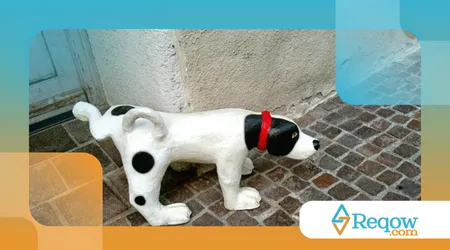Why do dogs lift their paw to pee?

Why do dogs lift their paw to pee? This canine enigma has intrigued owners and curious people for centuries.
Advertisements
Well, the scene is universal: the dog approaches a post, a tree or a tire and, in an almost ceremonial movement, raises one of its hind legs.
What's behind this peculiar gesture? Is it simply a matter of physiological relief, or is there a complex communication at play?
The Olfactory Alphabet of Dogs
For us, pee is waste. For dogs, however, it's the equivalent of business card. Urine is a chemical cocktail rich in pheromones and information.
Therefore, each droplet deposited serves as a "signature" detailed information about the individual. Age, sex, reproductive status, and even social hierarchy are all there.
Advertisements
They live in a sensory universe dominated by aromasCanine communication passes more through the nose than through the eyes or ears.
Marking territory is not just an act of possession; it is a exchange of information constant and silent.
The height of the marking is the key point in this complex social interaction chemical.
The Vertical Strategy: The Height Game
Thus, by raising its paw, the dog is trying to convey its message as high as possible. This posture is not random.
The purpose of raising the paw is to reach optimization. It's a brilliant, almost engineering strategy.
The higher the scent is deposited, the more easily it will be scattered by the wind. Furthermore, the brand is beyond the reach of other forms of dispersion.
This elevated height also projects a larger image of the dog that urinated. It's a chemical optical illusion.
When reaching a higher point, the marking simulates the scent of a dog taller and more robustThe raised paw is a propaganda trick.

Gender and Maturation: The Revelation of Posture
Generally, this posture is observed more frequently in adult and sexually mature males.
Puppies, both male and female, typically urinate in a squatting position. They focus on urination.
Read more: Interesting facts about dog breeds that almost disappeared
As males mature, around six to twelve months, they begin postural learning. It's a social transition.
Females, for the most part, keep squattingThey use urination primarily for relief and to a lesser extent for territorial marking.
However, some females may occasionally raise your paw to mark, especially if not spayed.
This behavior in females often indicates a high social trust or need to establish dominance in an environment.
The Science Behind the Hanging Paw
A 2013 study by scientists at Cornell University, published in the Journal of Comparative Psychology, offers insights fascinating.
The research quantified urination and marking behavior in different breeds. The conclusion is that adult males tend to maximize the height of urination in socially relevant places.
That is, they are not just emptying their bladder; they are investing in communication. They care about olfactory visibility.
Find out more: Technology at the Service of Animal Welfare: Smart Devices for Pets
The act of lifting the paw is an adaptation that transforms the eliminatory behavior in communicative behavior.
Consider, for example, the difference between urinating in a flat surface and on the floor. The mark disappears faster.
Now compare this to urine in a metal pole 40 cm from the ground. The odor lingers and travels.
It's Not About Quantity, It's About Quality
Another crucial point is the amount of urine released. Often, when marking, the dog releases only a small amount.
It's what we call marking urination, distinct from elimination urination, which is voluminous.
When storing large volumes for disposal and use small doses for communication, it is efficient.
In other words, he can spread his “message” throughout more different locations. It is a strategic economy of resources.
After all, why waste all your valuable perfume on one only billboard, when can you have multiple flyers?
This economy of urine demonstrates a territorial intelligence remarkable and adaptive. It's pure resource management.
The Poodle and the Spine Why do dogs lift their paws to pee?
Imagine a small Toy Poodle raising his paw to mark a concrete pillar. He's literally trying hard.
He stretches as far as he can, almost losing his balance, to reach the mark of a Labrador.
Look how interesting: How to Train Cats: Effective Techniques for Felines
Its small volume of urine, deposited high up, is intended to compete with the “billboard” of the larger dog. He is disguising his size.
This is a clear example of how the posture compensates for physical size. It's the little one claiming his space.

The Brand Race in the Park
In a busy park, every tree is a message board. Dogs take turns marking.
The act of lifting the paw ensures that the new mark do not contaminate or mix with the old marks.
He wants his message to be the fresher and more visible olfactorily. It's an attention competition.
Additional Factors That Influence
Therefore, several factors can influence the frequency and intensity of Why do dogs lift their paw to pee?.
THE environment is a significant factor. Places with a high concentration of other dogs generate more marking.
THE presence of a rival dog or a female in heat dramatically intensifies marking behavior.
THE castration in males, it can reduce the frequency of marking, but does not eliminate it completely. The social habit persists.
| Urination Behavior | Frequency in Non-Neutered Males | Main Purpose |
| Elimination Urination (Squatting) | Moderate | Bladder Emptying |
| Marking Urination (Paw Raised) | High | Olfactory Communication and Status |
The Mirror of Society
Think of this behavior as graffiti on a wall. The graffiti artist chooses a visible location.
He doesn't paint on the ground, where rain and trampling soon will erase your art. He seeks the top of the wall.
The dog, when lifting his paw, does the same. He is selecting the best place for your chemical “art”.
He wants the maximum longevity and visibility for its declaration of existence and dominance.
The canine behavior of raising the paw is a demonstration of ecological and social intelligence. It is effective communication.
After all, if information is power, Why do dogs lift their paw to pee? is it not a question of posture, but of supremacy? The answer is in the nose.
A Question of Status
The mystery behind Why do dogs lift their paw to pee? therefore reveals itself as a sophisticated communication strategy.
It is not mere relief; it is a status affirmation. The raised paw is the brush that draws the social map of the canine territory, a demonstration of trust and a clear message to those around them.
It is an instinctive behavior, but highly adaptive.
Frequently Asked Questions Why do dogs lift their paws to pee?
Do neutered dogs still lift their paw?
Yes, neutered dogs often retain the habit, although the frequency may decrease. The behavior becomes less hormonal and more of a learned social habit.
Is it normal for females to lift their paws?
It's less common, but normal. It can be observed in very confident, unneutered females (hormonal influence) or those living in environments with many males, adopting the posture as a way of competing for territory.
Should I correct paw marking indoors?
Inappropriate marking indoors is a behavioral problem, not just a postural one.
Correction should focus on the cause (anxiety, insecurity, hormones) and be done with positive reinforcement, not punishment. Neutering can help.
Why don't puppies lift their paw?
Puppies have not yet reached sexual and social maturity. They focus on elimination urination. The transition to marking posture is a milestone of canine puberty.
++ At what age does a dog lift its paw to urinate?
